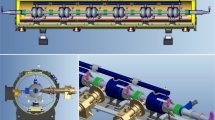Abstract
In the main part of the linear accelerator of protons at the Institute of Nuclear Research, Russian Academy of Science (INR RAS), the resonance cavities consist of four accelerating sections coupled by bridge coupling devices in a resonant system. The input of RF power is implemented in the middle coupling device. The cavity is configured as a multimode structure with a compensated operating mode and RF field existing simultaneously both in the sections and in the coupling devices. Justification for the availability and possibility of adjusting the magnetic field in the coupling devices to provide the RF input extends the possibilities of development of multisectional accelerating cavities.
Similar content being viewed by others
References
V. G. Andreev, V. M. Belugin, and V. V. Paramonov, “Bridge device for accelerators,” Tr. RTI AN SSSR 20, 47–55 (1974).
I. V. Rybakov et al., “Proposal of the accelrating structure for the first cavity of the main part of INR Linac,” in Proceedings of the Russian Particle Accelerator Conference RuPAC, 2016 (2017), p.216.
L. V. Kravchuk, et al., “Results of radio-technical tuning of the accelerating system of the main part of the LA MMF,” INR Preprint No. P-0710 (Inst. Nucl. Res. Acad. Sci. USSR, Moscow, 1991).
V. V. Paramonov, “The multi-mode analysis of the slotcoupled accelerating structures,” in Proceedings of the Linear Accelerator Conference LINAC 2002, p.413.
L. V. Kravchuk, et al., “Adjustment of the frequency characteristics of a multiresonator accelerating system,” INR Preprint No. P-0600 (Inst. Nucl. Res. Acad. Sci. USSR, Moscow, 1989).
L. I. Mandel’shtam, Lecture Notes on Oscillation (Nauka, Moscow, 1972) [in Russian].
G. Dome, “Review and survey of accelerating structures,” in Linear Accelerators, Ed. by P. Lapostolle and E. Septier (Horth-Holland, Amsterdam, 1970).
Author information
Authors and Affiliations
Corresponding author
Additional information
Original Russian Text © V.V. Paramonov, L.V. Kravchuk, I.V. Rybakov, 2018, published in Pis’ma v Zhurnal Fizika Elementarnykh Chastits i Atomnogo Yadra, 2018.
Rights and permissions
About this article
Cite this article
Paramonov, V.V., Kravchuk, L.V. & Rybakov, I.V. Input of RF Power into Coupling Element of Accelerating Cavity. Phys. Part. Nuclei Lett. 15, 915–918 (2018). https://doi.org/10.1134/S1547477118070555
Received:
Published:
Issue Date:
DOI: https://doi.org/10.1134/S1547477118070555




